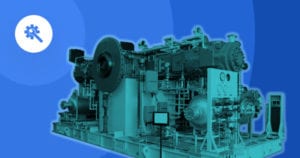![4 Ways IoT and Data Science Are Being Used to Fight Climate Change [7.30.19] Melting ice caps with a polar bear and the text](https://www.iotforall.com/wp-content/uploads/2019/08/4-Ways-IoT-and-Data-Science-Are-Being-Used-to-Fight-Climate-Change-7.30.19-696x435.png)
New technologies, such as the Internet of Things (IoT), artificial intelligence (AI), and applied data science in general, have the potential to advance our understanding and ability to effectively address climate change.
IoT Solutions for Our Changing Climate
One promise of IoT is to make all kinds of devices and environments more efficient and responsive to real-time fluctuations in use. What this means is that IoT systems at various levels of implementation can affect energy use and emissions. In 2015, researchers found that “the information and communications technology industry (which includes IoT) could help reduce greenhouse gas emissions by up to 63.5 gigatons, or 15%, across all industrial sectors by 2030.”
Green buildings are one use of IoT that could significantly reduce greenhouse gas emissions. Given that cities “account for almost three-quarters of the world’s carbon dioxide from global final energy use,” the potential for environmental impact by increasing green building construction is huge. Among other things, integrated IoT provides real-time data to improve buildings’ facilities costs. Green buildings can also reduce environmental impact by using eco-friendly building materials, increasing green space in cities, and being located efficiently to reduce commute times.
It’s no secret that overpopulation is negatively impacting our environment. Researchers predict that by 2050, two-thirds of the world’s population will live in cities, so it will only become more important to make those cities energy efficient. Smart cities can use IoT systems to make the water supply more efficient, improve congestion to reduce time spent in cars, and provide more reliable public transit. Smart cities can also implement energy-saving measures by encouraging remote working and monitoring trash and pollution.
IoT is relevant for farming communities as well. With the rising population, farmers will need to produce more food and do so using more sustainable methods. Current farming methods use water at a risky rate and result in soil degradation. Integrating IoT technologies, such as sensors that collect data about soil moisture, weather, and fertilization levels, can help farmers optimize their irrigation and production. Autonomous tractors could take care of drilling, seeding, and spraying to reduce human labor time.
Finally, IoT can be used to protect biodiversity in sometimes surprising ways. The Rainforest Connection is using IoT systems to identify and stop illegal logging. The Bee Corp uses IoT devices in hives to track the bees’ health and alert beekeepers, who can then intervene. Various wildlife preservations are using connected cameras to monitor large wild areas and illegal hunting and poaching.
We already see IoT integration in individual homes, but as this technology becomes more widespread at larger scales, its value in energy savings and other environmental benefits can be realized.
Carbon Capture Technologies
Because reforestation will take more time than we have to reduce carbon in the atmosphere, scientists have been exploring various carbon capture technologies for years. This tech works with coal, oil, or gas plants in either pre- or post-combustion stages to store carbon dioxide in underground storage tanks and ideally recycle it into usable fuel. For example, a plant in Iceland is capturing and recycling carbon to produce methanol.
This tech is still very much in development, as storing vast amounts of carbon underground is only a stopgap measure. But with more projects like the one happening in Iceland, the tech has real potential to change the landscape of traditional energy production as a complement to shifts to renewable energy production.
Using Big Data to Understand Earth Systems
The major contribution of data science is that it provides robust information and offers ways to disseminate that information to the public. The rise of big data has helped scientists understand past and present environmental and weather conditions to establish reliable trends, so we know what’s coming and how we can act.
Data generated by IoT systems can help us to conserve energy and water, but this data also helps scientists produce visualizations on climate change that better communicate to the public the real state of affairs. A lack of visualization has been one of the major challenges in getting widespread buy-in for climate-friendly policies.
Data science also helps deepen understanding of how different industries contribute to climate change and where the most critical environmental shifts—such as deforestation—are happening so that scientists and policymakers can take effective action.
For example, big data produced the knowledge that over one-quarter of global tree loss between 2001 and 2015 was associated with commercial deforestation. A project in California run by Planet Labs and the California Air Resources Board is launching a satellite to detect origin points of climate pollutants, such as methane, to target specific locations for mitigation.
Artificial Intelligence Helps Us Model an Unstable World
One of the challenges of addressing climate change is understanding trends and climate impacts of human behavior. AI is stepping in to help scientists build robust systems that sense and learn from environmental conditions and help humans figure out how to meet certain objectives.
Climate modeling, which is a scientific challenge given that we only have one planet to learn from, is greatly helped along by recent developments in AI. Using this technology, researchers will be better able to predict how the environment will respond to variables like carbon levels in the air, and in turn, to know what measures need to be taken to protect vulnerable human populations.
AI will also help climate policy and solutions improve. As a Brookings article explains, “AI helps make markets more efficient and easier for analysts and market participants to understand highly complex phenomena—from the behavior of electrical power grids to climate change.” Employing AI to make energy systems more efficient is the first step. As the technologies become better integrated with each other, machine learning will help scientists make sense of all the data statistically to propose effective adaptation policies.
Scientists can use machine learning to quickly test how their theories will play out in real-time to identify the best interventions. IBM’s Green Horizon Project, for instance, analyzes environmental data and tests “what-if” outcomes of pollution-reducing tactics. Microsoft is so sure that AI is a game-changer for progress in addressing climate change that it has committed $50 million through its AI for Earth program to projects creating new AI applications.
The technologies improving our understanding of climate change are robust enough that a new field is developing: climate informatics. First laid out in an article by Claire Monteleoni and co-authors in 2012, this discipline bridges the gap between climate scientists and AI researchers to explore the full potential of using tech to better understand what’s happening with our climate. As these various fields come together, climate research will be that much more effective, able to produce on-target policy changes, perhaps quickly enough to save us from the impending climate disaster.
Written by Brandon Jarma, a freelance writer who covers all things IoT, tech, and AI.





 Related Podcast Episode
Related Podcast Episode




 Related Applications
Related Applications


 Latest IoT News
Latest IoT News










